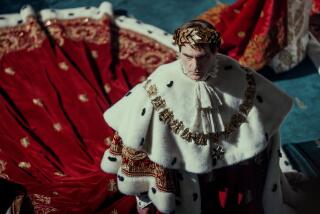Petraeus’ ‘ribbon creep’
- Share via
Gen. David H. Petraeus may be as impressive a military professional as the United States has developed in recent years, but he could use some strategic advice on how to manage his sartorial PR. Witness his congressional testimony on the state of the war in Iraq. There he sits in elaborate Army regalia, four stars glistening on each shoulder, nine rows of colorful ribbons on his left breast, and various other medallions, brooches and patches scattered across the rest of the available real estate on his uniform. He even wears his name tag, a lone and incongruous hunk of cheap plastic in a region of pristine gilt, just in case the politicians aren’t sure who he is.
That’s a lot of martial bling, especially for an officer who hadn’t seen combat until five years ago. Unfortunately, brazen preening and “ribbon creep” among the Army’s modern-day upper crust have trumped the time-honored military virtues of humility, duty and personal reserve.
Think about any of the generals you’ve seen in recent years -- Norman Schwarzkopf, Barry McCaffrey, Wesley Clark (all now retired) and others -- and the image you’ll conjure no doubt includes a chest full of shimmering decorations. In Petraeus’ case, most of them don’t represent actual military action as much as they do the general’s devotion to the institution of the U.S. Army and vice versa. According to an annotated photograph produced by the Times of London last year, the majority of ribbons on Petraeus’ impressive “rack” were earned for various flavors of distinguished service. As brave as he may be and as meritorious in general, is all that ostentation the best way to present the situation in Iraq to an increasingly war-skeptical public?
Of course, Petraeus’ goal is not just to make simple, soldierly arguments before Congress -- it is to dazzle, at least initially, with the blazing imagery of rank. What, after all, are mere Brooks Brothers suits on the members of Congress in the face of a fighting man’s laurels? Some of the showiness can be attributed to regulations: The official uniform of the Army is to be worn in a very specific manner, and the brass have an obligation to live up to their billing by showing plenty of ... well, brass. On the other hand, if you’re wearing four stars, you surely have some say when it comes to matters of peacockery.
Medals and decorations have a long history with a slightly cynical tinge. This goes back to their inception, during the Napoleonic era, when the strategic genius from Corsica discovered that baubles handed out to the combatants helped ensure loyalty and ferociousness. “With a handful of ribbons, I can conquer all of Europe,” he said. In more contemporary times, decorations have suffered a fraught reputation among the rank and file: nice to get but awkward to display if the memories associated with them are of violence, loss and the ineptness of commanders. There have been isolated incidents of Iraq war veterans returning their medals, and, of course, Vietnam War vets were better acquainted with this kind of protest.
The greatest military leaders, in the age of organized national armies, have often conspicuously modified the official requirements of the uniform, even in the most public of settings. Ulysses S. Grant accepted Robert E. Lee’s sword while outfitted in disheveled Union blue and muddy boots. Douglas MacArthur presided over the signing of the Japanese Instrument of Surrender on the deck of the battleship Missouri without donning so much as a necktie with his khakis. George Patton was flamboyant, in his jodhpurs and riding boots, but he backed it up in battle after battle. His legend derived equally from brilliant tactics and an outrageous wardrobe.
Perhaps the best example, however -- and one that Petraeus and his cadre should look to for inspiration -- was set by two of the most politically savvy generals America has produced: Dwight Eisenhower and George Marshall. In photographs following World War II, with Ike fresh from rescuing Western civilization while Marshall was working to rebuild it, both men appear victorious, yet somber, cognizant of the challenges met and the challenges ahead. Eisenhower wears a single row of ribbons, Marshall three.
When you’ve saved the world and managed the lives and deaths of millions, it obviously compels a certain level of modesty about showcasing your accomplishments, however monumental. Apparently when you’re trying to explain why your war-fighting achievements are “fragile” and why the conflict you’re running in a hot, dusty faraway place might never be won, it does not.
Memo to Petraeus: When you’re making the case for more patriotic gore, go easy on the glitter.


